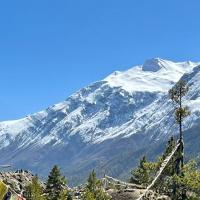
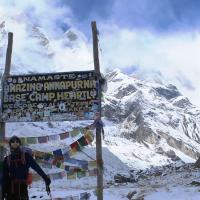
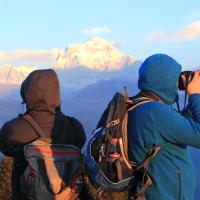
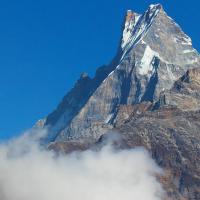

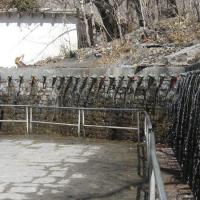
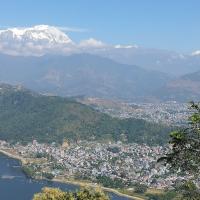
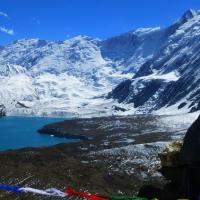
"An exemplary route to one of the most noteworthy mountains in the Himalayas."
Annapurna Base Camp (ABC) Trek is a meandering walk to the base camp of the 10th highest mountain in the world. After a 9-day trek through the Annapurna conservation area, villages, settlements, streams, and forests, you will reach the heart of the Annapurna mountains, popularly known as the “Annapurna Sanctuary.”
From this natural amphitheater to the base camp of Annapurna I (4,130 m/13,550 ft), you will see eleven snow-capped mountains such as Mt. Annapurna (8,091m/26,545ft), Mt. Machhapuchre (6,993m/22,943ft), Mt. Dhaulagiri (8,167m/26,795ft), Mt. Himchuli, ringed up within the diameter of 10 miles. Where in the world can you find the mountain sights superior to this? Only after you venture on this trek will you realize why the mountain man, Sir Edmund Hillary, called this trek “one of the best mountain sights in the world.”
Annapurna Base camp adventure begins as we drive from the scenic lake city of Pokhara to Tikhedunga as the road has reached there. Onwards, we take a scheduled course to ABC that lets us pass through the delightful Gurung towns of Ulleri, Ghorepani, Poonhill viewpoint, Tadapani, Chommrong, Bamboo, and Deurali.
Furthermore, we walk over to another esteemed mountain’s base camp- Machhapuchre Base Camp- from where we head towards Annapurna Base Camp. Finally, we have to trek down for a day to Bamboo, where we fork our trail towards Jhinu Danda to give a twist for the last day’s walk. As we reach the natural city of Pokhara, we will celebrate our successful trek along the bank of the famous Phewa Lake and return to Kathmandu.
For those considering a different alternative path, there are a couple of other courses at lower elevations from Pokhara to the interface at Chommrong. Depending upon your available time and interest, you can pick a trek from either Dhampus to Ghandruk or Nayapul to Tikhedunga. However, the trail ahead from Chommrong onward will be the same. Keeping Poonhill in mind, a great vantage point for observing the Annapurnas, we have included it in our standard itinerary from Nayapul to Tikhedhunga.
If there’s any trek worth going on in the Nepalese Himalayas, then this 14-day trek to the ABC is the one for you. So, contact Icicles Adventure Treks today and take time out from your daily schedule to create some unforgettable memories in Nepal.
Welcome to Nepal! Upon your arrival at Tribhuvan International Airport in Kathmandu, complete your customs and visa formalities. One of our office representatives will be there holding an Icicles Adventure Treks sign board with your name. He will transfer you to the hotel in Kathmandu of your choice. Check-in at your hotel and rest, or perhaps take some fresh air strolling around the Thamel area.
We start our day with breakfast at the hotel and going for one-day sightseeing around UNESCO world heritage sites within Kathmandu. Starting from Kathmandu Durbar Square, we go to the monkey temple of Swayambhunath, then take a drive to Pashupatinath and finally end at Boudhanath. All these heritage sites are worth visiting that shows us the best of Nepalese culture, Hindu and Buddhist religion, values, architectures, and temples. We also do organize a meeting about our trek and complete our preparation.
Meet your trekking guide, get familiar with the trek, and enjoy the rest of the day.
We take a 6-7 hours long drive to Pokhara, enjoying green valleys, ridges, rivers, fields, and settlements along the drive. We do have a lunch stop in a restaurant. A
Upon arrival at beautiful lake city, Pokhara, we will enjoy the overall atmosphere, take a stroll around the lakeside of Phewa Lake or simply shop and hop into any nice restaurant, or pubs.
The journey begins after breakfast at our hotel in Pokhara, we drive to Tikhedhunga, the village from where we start the walk. The next phase is a trek to Ulleri, another village that lies at an elevation of 2050 meters (6725 feet). The trek from Tikhedhunga to Ulleri is known for its steep stone staircases, comprising approximately 3,300 steps. This part of the trek offers a challenge and is famous for its beautiful scenery, including terraced fields and views of the surrounding mountains. We stay at a teahouse in Ulleri enjoying the views of mountains.
We leave Ulleri after breakfast. The trail ascends. We reach Banthanti and the trail then winds through oak and bamboo forests through the bank of beautiful stream. This offers a chance to experience the rich biodiversity of the region. We have lunch at Nangethanti and the later part of the trek is walk through lush forests of rhododendron, the national flower of Nepal. Depending on the season, trekkers might witness these forests in full bloom, painting the landscape in vibrant colors. The forests between Ulleri and Ghorepani are home to a variety of wildlife. Birds, including different species of pheasants, and occasionally, langur monkeys can be spotted along the trail. Along the way, there are several tea houses and small villages where trekkers can rest, enjoy local Nepali tea, and have snacks or lunch. These stops also provide opportunities to interact with locals and learn about their lifestyle and culture. Upon reaching Ghorepani, trekkers are greeted with stunning views of the Annapurna and Dhaulagiri mountain ranges. Ghorepani is a bustling village with a wide range of accommodations and dining options. If you have time and energy, trekkers can explore the village of Ghorepani or simply relax and acclimatize to the higher altitude. Enjoying the sunset over the Himalayas can be a memorable part of the evening.
We start early before dawn to hike to Poon Hill, aiming to reach the summit in time to witness one of the most spectacular sunrises over the Himalayas. The ascent is relatively steep but short (1.5 km one way) and upon reaching the top, trekkers are rewarded with panoramic views of the Annapurna and Dhaulagiri ranges, including Annapurna South, Annapurna I, Dhaulagiri, and Machhapuchhre (Fishtail Mountain).
After returning to Ghorepani and having breakfast, we set out towards Tadapani. This portion of the trek involves descending through rhododendron forests, offering more enchanting views and a chance to observe the local flora and fauna. The trail from Ghorepani to Tadapani is known for its natural beauty, with several spots offering majestic views of the snow-capped peaks.
The trek passes through the villages of Deurali and Banthanti before making a final ascent to Tadapani. Tadapani provides a serene environment, surrounded by forests, and is a great place to enjoy the peace and beauty of the Himalayas.
The trek from Tadapani to Chhomrong is a picturesque segment of many trekking routes in the Annapurna region, notable for its stunning mountain views and insights into local Gurung culture. This part of the trek descends through beautiful forests, crosses rivers, and passes through villages, offering a blend of natural beauty and cultural experiences.
The trek begins with a descent through lush rhododendron forests, which are particularly vibrant in the spring when the flowers are in bloom. The path offers splendid views of the Annapurna South, Hiunchuli, and Machhapuchhre (Fishtail Mountain) as it winds down to the Kimrong Khola (river). After crossing the river, there's a gradual ascent followed by a descent to the village of Gurjung, which provides an opportunity to experience the daily lives and culture of the Gurung people.
From Gurjung, the trail ascends again, offering more picturesque views of the surrounding mountains. The final stretch to Chhomrong is a mix of gentle climbs and level paths. Chhomrong is a large and bustling Gurung village that serves as a crucial junction for trekkers heading towards the Annapurna Sanctuary. The village offers excellent views of the Annapurna massif and the valley below.
The trek from Chhomrong to Dovan is an integral part of the journey towards the Annapurna Base Camp, situated in the heart of the Annapurna Sanctuary. This leg of the trek takes you deeper into the sanctuary, showcasing the rich biodiversity of the region and offering mesmerizing views of the Himalayas.
The trek begins with a descent from Chhomrong down a series of stone steps to the Chhomrong Khola (river). This initial part is quite steep and can be challenging on the knees. Crossing the suspension bridge over Chhomrong Khola marks the start of the ascent towards Sinuwa. This section is known for its steep and continuous uphill path but rewards trekkers with stunning views of the surrounding mountains and valleys. From Sinuwa, the trail becomes relatively more level and passes through dense forests of bamboo and rhododendron. The path here is serene, with the sound of the river accompanying trekkers as they move through the heart of the Annapurna Sanctuary.
The final stretch to Dovan is through a narrower valley, where the dense forest provides a canopy overhead. Dovan is a small settlement situated at the confluence of two rivers, offering basic lodging facilities for trekkers. The area around Dovan is known for its natural beauty, with the towering Himalayas overhead and the forested valley providing a tranquil setting.
The walk from Dovan to Machhapuchre Base Camp (MBC) offers trekkers an immersive experience in the heart of the Himalayas, surrounded by majestic peaks and stunning landscapes. The transition from lush forests to rugged alpine terrain is a highlight for many trekkers. Today’s trek offers stunning views of Hiunchuli, Annapurna South, Annapurna III, Gangapurna, and, of course, Machhapuchre itself. The lower sections of the trail are rich in biodiversity, including dense forests of rhododendron and bamboo, which are home to various bird species and wildlife.
The trail from Dovan to MBC progressively ascends through dense forests, crossing several streams and waterfalls. As you ascend, the vegetation starts to thin, offering clearer views of the surrounding mountains. The path becomes steeper and more challenging as you approach Deurali, the last stop before MBC, situated at around 3,200 meters (10,500 feet).
From Deurali, the trail continues to ascend, leaving the treeline behind and entering a more alpine environment. The landscape opens up, presenting dramatic views of the surrounding peaks, including Machhapuchre (Fishtail Mountain), which dominates the skyline.
Trekking from MBC to ABC is a highlight for many trekkers in the Himalayas, providing an awe-inspiring experience amidst the giants of the natural world. The journey not only challenges the body but also enriches the spirit, offering profound moments of connection with nature's grandeur.
This segment of the trek covers a shorter distance compared to other days on the trail but involves a significant elevation gain, leading trekkers into the heart of the Annapurna Sanctuary, a high glacial basin surrounded by a ring of towering Himalayan peaks. The distance from MBC to ABC is approximately 3 to 4 kilometers, with an elevation gain of around 430 meters (1,410 feet). Despite the relatively short distance, the trek can take about 2-3 hours to complete, depending on individual pace, weather conditions, and acclimatization to the altitude.
The trail from MBC to ABC is less forested and more open, offering unobstructed views of the surrounding mountains. The path is well-defined and gradually ascends through alpine meadows and over rocky terrain. The environment is stark and majestic, with the high mountains of the Annapurna range encircling the valley.
As trekkers approach ABC, the trail becomes somewhat steeper, but the sight of the Annapurna Massif, including Annapurna I, Annapurna South, Annapurna III, and Machhapuchhre, provides a breathtaking backdrop that motivates many to push forward. The final approach to ABC opens up to a wide plateau, offering panoramic views of the snow-capped peaks and glaciers.
If the afternoon/evening weather is clear, trekkers will enjoy the dramatic panorama. As the sun begins to set, the changing light casts spectacular colors on these towering peaks, creating dramatic and breathtaking vistas. with the snow-capped mountains reflecting hues of pink, orange, and red. The sight of these giants bathed in the warm glow of the setting sun is a highlight for many trekkers and photographers. It's a moment of profound beauty and tranquility, offering a unique opportunity to witness the majesty of the Himalayas in a new light. Dress warmly, as temperatures can drop quickly once the sun goes down. Bring your camera and prepare to capture one of the most memorable scenes of your life.
The day begins early, with trekkers waking up before dawn to catch the first rays of the sun illuminating the Annapurna massif. The experience of watching the sunrise at ABC is unparalleled, as the snow-capped peaks, including Annapurna I, Annapurna South, Machhapuchhre (Fishtail Mountain), and Hiunchuli, gradually light up with an orange and pink glow.
After breakfast, we retrace steps back down the valley, passing through MBC before descending further into the Modi Khola valley. The path leads through the same stunning landscapes encountered on the ascent but offers a new perspective as trekkers are now facing the opposite direction, with views opening up ahead of them.
As the elevation decreases, the alpine meadows and rocky terrain give way to lush forests filled with rhododendrons, bamboo, and oak trees. The sound of rushing streams and the sight of waterfalls accompany trekkers as they make their way down the valley.
The main challenge on this day is the strain on knees and leg muscles as we descend 2000m today. It's important to take it slow, use trekking poles for support, and take regular breaks to rest and hydrate. The risk of slipping on loose gravel or wet stones is also higher, so careful footing is essential.
The trail initially involves a gradual ascent through lush forests filled with rhododendrons and bamboo, eventually leading to a steep descent to the Modi Khola river. After crossing the river, there's a final climb to reach Jhinu Danda. Along the way, trekkers are treated to beautiful views of the surrounding mountains and valleys, with the landscape gradually transitioning from the alpine scenery of the higher altitudes to the subtropical environment of the lower regions. One of the day's highlights is the opportunity to soak in the natural hot springs located near Jhinu Danda. These springs are a short walk from the main village and offer a relaxing and rejuvenating experience, especially after days of trekking. The hot springs are situated beside the Modi Khola river, providing a picturesque setting for relaxation.After reaching Jhinu Danda and perhaps enjoying the hot springs, we drive back to Pokhara. The drive can take around 3 hours. The drive back to Pokhara offers a different perspective of the Nepalese countryside, with scenic views of hills, rivers, and local villages along the way. It's a chance to reflect on the trekking experience while transitioning back to urban life.
We drive towards Kathmandu leaving back the trails of ABC and Pokhara. Upon arrival at capital city, we will organize farewell dinner at one of the cultural restaurant with good performances.
Quick Note: You also have an option to extend your Nepal trekking trip with an extra day at Pokhara to explore even more natural and cultural attractions. Similarly, Chitwan Safari, Rafting, or Bungee jumping and Paragliding, Everest mountain flight and there are many more activities that you can experience while you are in Nepal.
With plenty of wonderful Annapurna Base Camp Trekking memories, you will be transferred to TIA for your scheduled international flight by one of our office representative. We hope that you like our services, and look forward to organize even more treks, tours and adventures in near future. Farewell!
Annapurna Sanctuary Trek is comparatively easier than other high altitude treks and anyone who loves to travel with a normal fitness level can join this trip. Previous trekking experience is not required and one of the best trips to join if you are first time trekking in Nepal. Begin your preparations with daily workouts and cardio exercises like running, skipping, treadmill, cycling, etc which will help you increase your stamina and take on the challenge put in front of you. If you are taking any medications especially of blood pressure, cholesterol, neurology, and respiratory system, then you need to consult your doctor before planning the trip.
In short, if you are physically fit with passion towards hiking the Himalayas then this Annapurna trail is definitely for you.
ABC is a popular tea house (lodge to lodge) trekking with well-developed trails along the route. These tea houses are clean and provide basic to standard facilities at a twin-sharing basis. There are single and dormitory rooms also available and above Dovan, to ABC, there are only six teahouses at each stopping point, therefore at the high season, you might need to sleep at dining hall too. Also, the toilet is usually squat-style outside the room.
We offer three meals a day, i.e. breakfast, lunch, and dinner during all of our trekking days. If you are vegetarian, then it is advised to inform us in advance so that we can arrange the meal items accordingly. At lower elevations, there are many items whereas as the altitude rises, prices of meals go high, and usually are rice and lentil, noodles, pasta, porridge, bread, including Nepali, Indian, and Tibetan style food.
ACAP has introduced a number of safe and cheapest drinking water stations at several spots of the conservation area. If there aren’t any, then you are advised to use the iodine tablets for purification.
Always ask for boiled (and cooled) water at your tea house. Don’t use water from a local sources and don’t use plastic water bottles as it causes environmental pollution.
There are basically two main trekking seasons in Nepal. One is during the spring season in March, April, and May months whereas another one is during the autumn season in September, October, and November. There will be blossoming rhododendron trees during the spring season while clear views of the Himalayas at the perfect temperature during autumn. Both of these times are best for trekking.
You are advised to pack less but don’t miss any essential stuffs. First of all, if you already have your down jacket, trekking shoes, sleeping bag, mat, then it is advised to bring them with you. Or, you also have an option to buy or rent at Kathmandu/Pokhara. Packing essentials are listed here.
For this trekking, every non-Nepali citizen should obtain ACAP permits and a TIMS card. Both of these permits will be arranged by our company. All you need to do is bring a couple of pp size photographs to fill up the forms.
Travel insurance is mandatory for all trekkers and you are recommended to get a travel insurance policy that covers helicopter rescue (medical evacuation) up to 4000m for ABC trek. You can get it online from your home country. This travel insurance will provide peace of mind and economically beneficial during contingencies.
Legally, you do not need any vaccinations to enter Nepal. But it is recommended to consult a nearby physician and get Malaria, Typhoid, Meningitis, and/or other vaccinations especially if you are visiting during the summer or spring season when mosquitoes and other bugs appear.
You are already supporting the local economy if you are traveling with companies like Icicles Adventure Treks that hire local porters and creates employment opportunities. Also, the prices of basic meals are fixed by the local Tourism Management committee, so please do not bargain on the given price. You don’t need to pay for the 3 times meal per day during the trek as they are included in your trip cost.
You can also support local inhabitant’s business by buying locally produced goods and services. However, don’t buy items made from wildlife parts. It is best to leave flora and fauna at their natural state, without disturbing them.
There are two major cell phone operators in Nepal, NTC, and NCELL. You can easily get gsm sim cards at Kathmandu Airport or at most of the local stores/communication shops. Most of the hotels/restaurants at Kathmandu and Pokhara offer free wifi and you can see few cyber cafes in tourist areas.
In the Annapurna trail, you can recharge your mobile, and camera freely at hotels in lower elevations. However, at higher elevations as you reach near base camp, you might have to pay a little extra amount (a couple of hundred rupees) for charging batteries. Most charging is made available at the dining hall. Make sure to get an extension plug for charging. If you have extra batteries, then it would be even better.
We are a travel company that focuses on sustainable tourism policies and we do put in practice by organizing treks that have minimum negative impacts on the environment and society. You are not advised to lit a campfire especially near forest areas, we advise you to order the same meal for all members of the group to save the fuel for cooking. You will be also carrying out what you carried in and minimize the use of plastic materials. In short, trekking ABC with Icicles means conserving forest, stopping pollution, and also protecting the wildlife.
The first and foremost safety trekking trip would be never trek alone. Always trek with the authorized trekking guide.
You also need to have information on altitude sickness, you need to be alert while taking photos and trek at your own pace, it's not a race after all; enjoy every moment of it.
Yes, like most of our trips, Annapurna Base Camp is also customizable and can be tailor-made (modified) according to the need and requirements of clients. Either you are looking to skip Kathmandu sightseeing and directly start trekking from Pokhara or add extra days; it is always possible. For tight budget travelers to luxurious trips, we organize treks just like our client’s wish. Simply let us know your vacation (holiday) plans, and we will make it happen.
These are standard group departures for Annapurna Base Camp Trek trip. We understand these departures may not suit your schedules, if so, please feel free to ask a customized departure date that suits you. Also, if you are looking for a different customized itinerary, please ask our local travel specialist for a new personalized, customized program as per your interests and requirements.
| Trip Start Date | Trip End Date | Seat Left | Price (USD) | Status | |
|---|---|---|---|---|---|
|
Friday
18-Apr, 2025 |
Thursday
01-May, 2025 |
- | USD 1290 | Book Now | |
|
Friday
25-Apr, 2025 |
Thursday
08-May, 2025 |
- | USD 1290 | Book Now | |
|
Friday
02-May, 2025 |
Thursday
15-May, 2025 |
- | USD 1290 | Book Now | |
|
Friday
09-May, 2025 |
Thursday
22-May, 2025 |
- | USD 1290 | Book Now | |
|
Friday
16-May, 2025 |
Thursday
29-May, 2025 |
- | USD 1290 | Book Now | |
|
Friday
23-May, 2025 |
Thursday
05-Jun, 2025 |
- | USD 1290 | Book Now | |
|
Friday
30-May, 2025 |
Thursday
12-Jun, 2025 |
- | USD 1290 | Book Now | |
|
Friday
05-Sep, 2025 |
Thursday
18-Sep, 2025 |
- | USD 1290 | Book Now | |
|
Friday
12-Sep, 2025 |
Thursday
25-Sep, 2025 |
- | USD 1290 | Book Now | |
|
Friday
19-Sep, 2025 |
Thursday
02-Oct, 2025 |
- | USD 1290 | Book Now | |
|
Friday
26-Sep, 2025 |
Thursday
09-Oct, 2025 |
- | USD 1290 | Book Now | |
|
Friday
03-Oct, 2025 |
Thursday
16-Oct, 2025 |
- | USD 1290 | Book Now | |
|
Friday
10-Oct, 2025 |
Thursday
23-Oct, 2025 |
- | USD 1290 | Book Now | |
|
Friday
17-Oct, 2025 |
Thursday
30-Oct, 2025 |
- | USD 1290 | Book Now | |
|
Friday
24-Oct, 2025 |
Thursday
06-Nov, 2025 |
- | USD 1290 | Book Now | |
|
Saturday
25-Oct, 2025 |
Friday
07-Nov, 2025 |
- | USD 1290 | Book Now | |
|
Friday
31-Oct, 2025 |
Thursday
13-Nov, 2025 |
- | USD 1290 | Book Now | |
|
Friday
07-Nov, 2025 |
Thursday
20-Nov, 2025 |
- | USD 1290 | Book Now | |
|
Friday
14-Nov, 2025 |
Thursday
27-Nov, 2025 |
- | USD 1290 | Book Now | |
|
Friday
21-Nov, 2025 |
Thursday
04-Dec, 2025 |
- | USD 1290 | Book Now | |
|
Friday
28-Nov, 2025 |
Thursday
11-Dec, 2025 |
- | USD 1290 | Book Now | |
|
Friday
28-Nov, 2025 |
Thursday
11-Dec, 2025 |
- | USD 1290 | Book Now | |
|
Friday
05-Dec, 2025 |
Thursday
18-Dec, 2025 |
- | USD 1290 | Book Now | |
|
Friday
05-Dec, 2025 |
Thursday
18-Dec, 2025 |
- | USD 1290 | Book Now | |
|
Friday
12-Dec, 2025 |
Thursday
25-Dec, 2025 |
- | USD 1290 | Book Now | |
|
Friday
19-Dec, 2025 |
Thursday
01-Jan, 2026 |
- | USD 1290 | Book Now | |
|
Friday
26-Dec, 2025 |
Thursday
08-Jan, 2026 |
- | USD 1290 | Book Now | |
|
Friday
02-Jan, 2026 |
Thursday
15-Jan, 2026 |
- | USD 1290 | Book Now | |
|
Friday
09-Jan, 2026 |
Thursday
22-Jan, 2026 |
- | USD 1290 | Book Now | |
|
Friday
16-Jan, 2026 |
Thursday
29-Jan, 2026 |
- | USD 1290 | Book Now | |
|
Friday
23-Jan, 2026 |
Thursday
05-Feb, 2026 |
- | USD 1290 | Book Now | |
|
Friday
30-Jan, 2026 |
Thursday
12-Feb, 2026 |
- | USD 1290 | Book Now | |
|
Friday
06-Feb, 2026 |
Thursday
19-Feb, 2026 |
- | USD 1290 | Book Now | |
|
Friday
13-Feb, 2026 |
Thursday
26-Feb, 2026 |
- | USD 1290 | Book Now | |
|
Friday
20-Feb, 2026 |
Thursday
05-Mar, 2026 |
- | USD 1290 | Book Now | |
|
Friday
27-Feb, 2026 |
Thursday
12-Mar, 2026 |
- | USD 1290 | Book Now | |
|
Monday
02-Mar, 2026 |
Sunday
15-Mar, 2026 |
- | USD 1290 | Book Now | |
|
Saturday
07-Mar, 2026 |
Friday
20-Mar, 2026 |
- | USD 1290 | Book Now | |
|
Friday
13-Mar, 2026 |
Thursday
26-Mar, 2026 |
- | USD 1290 | Book Now | |
|
Friday
20-Mar, 2026 |
Thursday
02-Apr, 2026 |
- | USD 1290 | Book Now | |
|
Friday
27-Mar, 2026 |
Thursday
09-Apr, 2026 |
- | USD 1290 | Book Now | |
|
Friday
03-Apr, 2026 |
Thursday
16-Apr, 2026 |
- | USD 1290 | Book Now | |
|
Friday
10-Apr, 2026 |
Thursday
23-Apr, 2026 |
- | USD 1290 | Book Now | |
|
Friday
17-Apr, 2026 |
Thursday
30-Apr, 2026 |
- | USD 1290 | Book Now | |
|
Friday
24-Apr, 2026 |
Thursday
07-May, 2026 |
- | USD 1290 | Book Now | |
|
Friday
01-May, 2026 |
Thursday
14-May, 2026 |
- | USD 1290 | Book Now | |
|
Friday
08-May, 2026 |
Thursday
21-May, 2026 |
- | USD 1290 | Book Now | |
|
Friday
15-May, 2026 |
Thursday
28-May, 2026 |
- | USD 1290 | Book Now | |
|
Friday
22-May, 2026 |
Thursday
04-Jun, 2026 |
- | USD 1290 | Book Now | |
|
Friday
29-May, 2026 |
Thursday
11-Jun, 2026 |
- | USD 1290 | Book Now | |
|
Tuesday
02-Jun, 2026 |
Monday
15-Jun, 2026 |
- | USD 1290 | Book Now | |
|
Friday
12-Jun, 2026 |
Thursday
25-Jun, 2026 |
- | USD 1290 | Book Now | |
|
Friday
04-Sep, 2026 |
Thursday
17-Sep, 2026 |
- | USD 1290 | Book Now | |
|
Friday
11-Sep, 2026 |
Thursday
24-Sep, 2026 |
- | USD 1290 | Book Now | |
|
Friday
18-Sep, 2026 |
Thursday
01-Oct, 2026 |
- | USD 1290 | Book Now | |
|
Friday
25-Sep, 2026 |
Thursday
08-Oct, 2026 |
- | USD 1290 | Book Now | |
|
Friday
02-Oct, 2026 |
Thursday
15-Oct, 2026 |
- | USD 1290 | Book Now | |
|
Friday
09-Oct, 2026 |
Thursday
22-Oct, 2026 |
- | USD 1290 | Book Now | |
|
Friday
16-Oct, 2026 |
Thursday
29-Oct, 2026 |
- | USD 1290 | Book Now | |
|
Friday
23-Oct, 2026 |
Thursday
05-Nov, 2026 |
- | USD 1290 | Book Now | |
|
Friday
30-Oct, 2026 |
Thursday
12-Nov, 2026 |
- | USD 1290 | Book Now | |
|
Friday
06-Nov, 2026 |
Thursday
19-Nov, 2026 |
- | USD 1290 | Book Now | |
|
Friday
13-Nov, 2026 |
Thursday
26-Nov, 2026 |
- | USD 1290 | Book Now | |
|
Friday
20-Nov, 2026 |
Thursday
03-Dec, 2026 |
- | USD 1290 | Book Now | |
|
Friday
11-Dec, 2026 |
Thursday
24-Dec, 2026 |
- | USD 1290 | Book Now | |
|
Friday
18-Dec, 2026 |
Thursday
31-Dec, 2026 |
- | USD 1290 | Book Now | |
|
Friday
25-Dec, 2026 |
Thursday
07-Jan, 2027 |
- | USD 1290 | Book Now |
Registered with: Company Registration Office, Government of Nepal
Licensed by: Nepal Tourism Board & Department of Tourism
Proud Member of Trekking Agency's Association of Nepal
General Member of Nepal Mountaineering Association
Life Member of Kathmandu Environmental Education Project